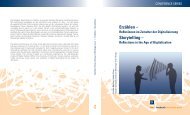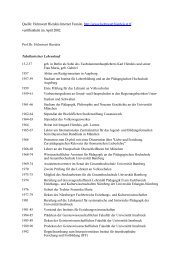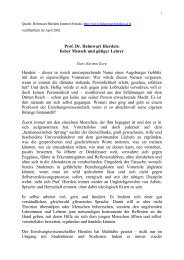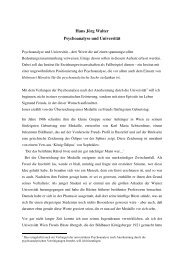Download pdf - Universität Innsbruck
Download pdf - Universität Innsbruck
Download pdf - Universität Innsbruck
Erfolgreiche ePaper selbst erstellen
Machen Sie aus Ihren PDF Publikationen ein blätterbares Flipbook mit unserer einzigartigen Google optimierten e-Paper Software.
The Sharing Turn 19<br />
plex group activity where one animal has to observe the spatial positions of the others.<br />
But, most researchers agree, there is no prior joint plan or division of roles among animals.<br />
Each participant strives to maximize his own chances for prey. “The group activities of<br />
apes”, writes Tomasello, “takes place in ‘I’ mode, not in ‘We’ mode” (p. 57).<br />
Tomasello and his colleagues conduct experiments with chimpanzees and Bonobos, our<br />
closest relatives among the primates, and with young children. His hypothesis: The forms<br />
of cooperation visible in children today reflect the earliest forms of cooperation in human<br />
history. They have the same basic structure as joint hunting of big game and gathering of<br />
berries (pp. 65, 75). Ontogeny recapitulates phylogeny – in our biological as well as in our<br />
cultural development.<br />
Animals including all other primates are egoists, rational maximizers of their personal<br />
benefits. Where there is sharing and caring behaviour is among family members. Among<br />
non-related individuals and often even among mother and child there is constant competition<br />
for food.<br />
As for us humans, one of the great debates in history concerns the question whether we are<br />
born cooperative and are corrupted by society later on (e.g. Jean-Jacques Rousseau) or<br />
whether we start out egoistic and are then educated by society (e.g. Thomas Hobbes).<br />
Tomasello's empirical findings: From about their first birthday when children begin to<br />
walk and speak and turn into truly cultural beings, they are spontaneously helpful and cooperative<br />
in many situations.<br />
At the age of nine months, children start playing with adults, simple games with balls and<br />
toy blocks. And they start to develop a “shared attention”. They watch the adult and her<br />
attention, and the adult watches the child's attention in an endless interplay of mutual observations.<br />
This ‘recursive mind-reading’ is the basis for the formation of a common conceptual<br />
background, of shared intentionality, of intersubjectivity (p. 62f.). Even before<br />
they can speak, kids inform others by pointing to things, things they understand to be relevant<br />
for others. Freely sharing information seems to be something that naturally occurs<br />
even with very small children (p. 31). Chimpanzees do not use pointing gestures among<br />
themselves (p. 26). Tomasello explains that in their world nobody altruistically directs<br />
others to food. They compete for it (p. 28f.). When a group of them hunted together they<br />
would fight over the prey. Children in research situations have been shown to be much<br />
more generous. Not that they always divided the goodies fairly, but when one child took<br />
more than its share and the other one complained, the first one would nearly always give<br />
in (p. 31ff.). So it seems that a sense of distributive fairness emerges early on and that we<br />
are naturally inclined to negotiate our way out of conflicts.<br />
Apes do not pursue activities with a common goal. In the experiments they never tried to<br />
communicate the formation of a common goal or a shared attention, while kids do this in<br />
various forms all the time (p. 62f.). Setting common goals is crucial for cooperation. In<br />
another set of experiments, Tomasello's group gave kids and young human-raised chimps
















